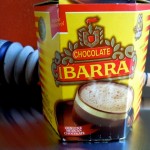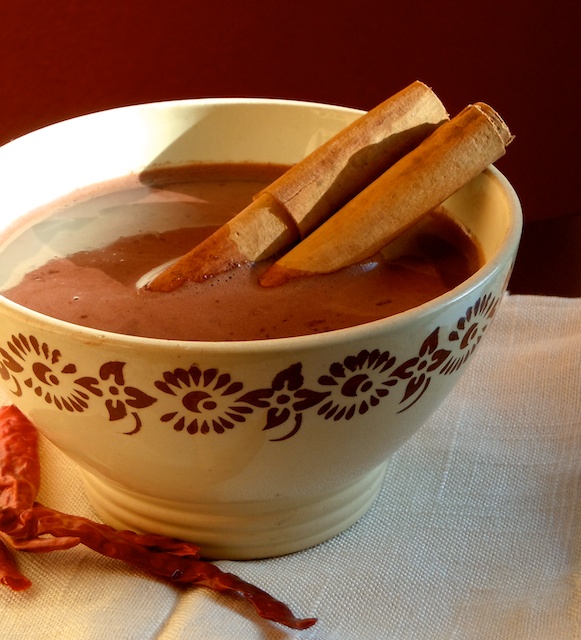 [S]ometimes it is necessary to fall under a spell. And my potion of choice recently has been hot chocolate. I have been inspired in the past and of late by a beautiful little film called Chocolat
[S]ometimes it is necessary to fall under a spell. And my potion of choice recently has been hot chocolate. I have been inspired in the past and of late by a beautiful little film called Chocolat (2000), which has its own mystical properties. Based on the novel by Joanne Harris, it is the story of a woman, Vianne Rocher, who moves to a rather stale and repressed French village to open a chocolate shop (the horror!) and during Lenten season to boot (gasp!).
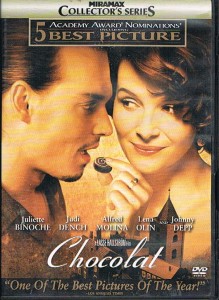 Vianne is mostly ostracized by the villagers, who consider her a witch, immoral and devious because she refutes the traditions of the times. She gradually wins them over, however, with her spellbinding kindness and the irresistible magic she makes out of chocolate. (For a taste of the film click here),
Vianne is mostly ostracized by the villagers, who consider her a witch, immoral and devious because she refutes the traditions of the times. She gradually wins them over, however, with her spellbinding kindness and the irresistible magic she makes out of chocolate. (For a taste of the film click here),
I have long been under the spell of the film myself and almost always come away from it with a deep hunger for the dark mysterious allure of chocolate. Particularly hot chocolate, which Vianne ladles up — her version looking as dark and rich as pudding and with a sprinkle of chile pepper on top — to her customers.
What is it about hot chocolate? It has been drank up for centuries, religiously by ancient cultures and aristocrats. It has been purported to have medicinal powers to cure many an ailment and been used as an aphrodisiac. Beyond anything, its depth and warmth make it a ritual of comfort to young and old.
We all grew up with Swiss Miss. Sure she’s easy enough, with her pre-measured packets and dehydrated marshmallows. There is a distinction, however, between hot cocoa — made from a powdered mix — and hot chocolate, created from a paste or solid chocolate. The real deal is easy enough, and so many variations! Try it yourself and you will feel like a sorceress at your stovetop.
Aztec ruler Montezuma had a thing for chocolate drinks…he had one every night before beddy-boo. Those conjuring hot chocolate south of the border have always had it right — a little spice is nice. Their chocolate drink recipes, along with the cocoa beans that were their base were so sought after that the Spanish appropriated them off to Europe. Mexican hot chocolate — like Mexican coffee — incorporates cinnamon. If you are leery of making hot chocolate from scratch, the Mexican hot chocolate wedges and tablets you can find in any grocery will give you an edge of the exotic.
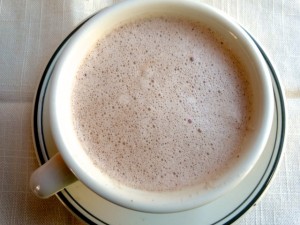 I recently made Mexican hot chocolate with Ibarra brand chocolate by simply heating milk and blending two wedges of a vary dense dark chocolate disk. Frothiness in many hot chocolate recipes is considered by many the ideal consistency. This can be achieved with a whisk, a blender or, if you prefer going very old-school, get yourself a molinillo, a wooden stick with a ridged barrel at the bottom that when placed in the pot of chocolate and churned between your hands (as if rubbing them together), gives the chocolate its foam and transports you back to seventh-century Spain where the tool was created.
I recently made Mexican hot chocolate with Ibarra brand chocolate by simply heating milk and blending two wedges of a vary dense dark chocolate disk. Frothiness in many hot chocolate recipes is considered by many the ideal consistency. This can be achieved with a whisk, a blender or, if you prefer going very old-school, get yourself a molinillo, a wooden stick with a ridged barrel at the bottom that when placed in the pot of chocolate and churned between your hands (as if rubbing them together), gives the chocolate its foam and transports you back to seventh-century Spain where the tool was created.
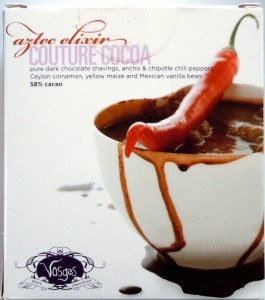 The spice of the Mexican hot chocolate, though delicious, did not completely satisfy me. I decided to try a mor exotic and upscale version in Vosges Haut-Chocolat’s Aztec Elixir. This hot chocolate mix, easily prepared by whisking it into warm milk, had more of what I was looking for. I had in my head what I thought was Vianne’s blend, or what I thought it was. Something blood dark and thick, clotted with spices and a bit of lingering fire to the tongue and throat.
The spice of the Mexican hot chocolate, though delicious, did not completely satisfy me. I decided to try a mor exotic and upscale version in Vosges Haut-Chocolat’s Aztec Elixir. This hot chocolate mix, easily prepared by whisking it into warm milk, had more of what I was looking for. I had in my head what I thought was Vianne’s blend, or what I thought it was. Something blood dark and thick, clotted with spices and a bit of lingering fire to the tongue and throat.
To make my own Morning Mayan Hot Chocolate (to use Vianne’s phrase from the film, “to awaken the passion”), I read numerous recipes and blended a few. I knew that the tradition here was to make a paste first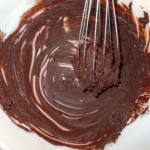 , and that that paste was thickened with flour or even cornmeal, as the Aztec Elixir was.
, and that that paste was thickened with flour or even cornmeal, as the Aztec Elixir was.
The paste is whisked into the milk and whisked until fully blended. Upon standing a little while, the chocolate thickens to a delightfully muddy consistency (and appearance!), bitter, marginally, but richly sweet from brown sugar, there is comfort there, yes, as in most hot chocolate, but something else, too, a fire, catching on the back of the throat, making the entire body tingle and wake up, senses opening to the world. More potion here than mere gentle libation.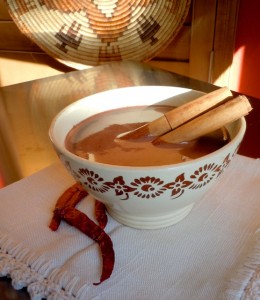
Morning Mayan Hot Chocolate
Makes 2 to 4 servings (depending on mug size)
3 cups milk
½ cup unsweetened cocoa powder (recommended, Pernigotti)
1 teaspoon flour
¼ cup brown sugar
One pinch of cloves
One pinch of nutmeg
1/2 teaspoon cinnamon, plus additional for garnish
One pinch each cayenne, ancho and chipotle chile powders
1 to 2 packets Stevia powder or artificial sweetener, if needed
1 teaspoon vanilla extract
Whipped cream for garnishs
Slowly heat the milk on low heat in a medium saucepan. Blend the cocoa and the flour in a small bowl, whisk in about 1/4 cup of the warm milk (a little more if necessary) until a smooth paste is formed. add the brown sugar and the spices to the paste, whisking until all lumps are removed. Add this mixture into the warm milk, stirring constantly. Remove from heat, add vanilla and extra sweetener, if adding. Allow chocolate to sit a few minutes before serving. Garnish with whipped cream and cinnamon, using cinnamon sticks as a stirring stick.
Midday in Paris
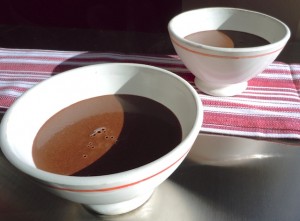 During my last viewing of “Chocolat,” I became not only obsessed with hot chocolate, but also the bowls from which they were drinking it in one of the film’s scenes. Drinking hot chocolate from a soup bowl held between your hands, what was this?! How primitive and elegant all at once! I found out they are called “cafe au lait bowls” or “breakfast bowls” and they are very French. And I had to have some. Through the online treasure palace known as Etsy,
During my last viewing of “Chocolat,” I became not only obsessed with hot chocolate, but also the bowls from which they were drinking it in one of the film’s scenes. Drinking hot chocolate from a soup bowl held between your hands, what was this?! How primitive and elegant all at once! I found out they are called “cafe au lait bowls” or “breakfast bowls” and they are very French. And I had to have some. Through the online treasure palace known as Etsy, 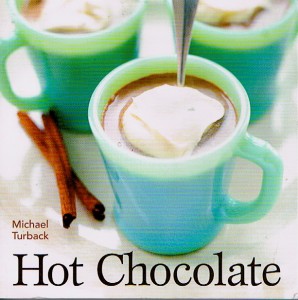 I chose bowls that spoke to me and guess what? They came from France! Merveilleux!
I chose bowls that spoke to me and guess what? They came from France! Merveilleux!
Do the French make the best hot chocolate? In my search across the great galaxy of Interspace, it would seem so. They certainly have long had a passion for “le chocolate chaud.” Apparently, Marie Antoinette had a personal chocolatier concocting her blends. The French recipe that keeps re-emerging time and again in my searches as THE best comes from a cafe in Paris, and I found it in a beautiful little book by Michael Turback called Hot Chocolate (2005). The hot chocolate is served at the Angelina cafe in Paris.
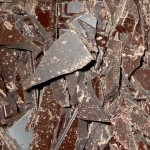 This style of hot chocolate is quite simple and terribly rich — milk, cream, finely chopped bittersweet chocolate, sugar and yet more cream to top it off. Thick and dessert-like, it’s an effective, uplifting afternoon pick-me-up.
This style of hot chocolate is quite simple and terribly rich — milk, cream, finely chopped bittersweet chocolate, sugar and yet more cream to top it off. Thick and dessert-like, it’s an effective, uplifting afternoon pick-me-up.
Le Chocolat L’Africain
Angelina, Paris, France
From “Hot Chocolate” by Michael Turback (2005)
Makes 2 demitasse servings
3/4 cup whole milk
1/4 cup heavy cream
1 teaspoon confectioners’ sugar, or to taste
4 ounces bittersweet chocolate, chopped
Whipped cream
In a small saucepan over medium high heat, combine the milk, cream and sugar in a saucepan and heat just until bubbles appear around edges of the pan. Remove the pan from the heat and add the chocolate, stirring with a wooden spoon until the chocolate is completely melted. If necessary, return the pan to low heat, stirring constantly until the chocolate is melted. The mixture should appear smooth and evenly colored. Serve warm, not hot, in demitasse or espresso cups with softly whipped cream on the side.
Blogger’s Note: Serve it dainty demitasse if you like, but this recipe will make one large mug or cafe au lait bowl of chocolate.
Lavender Lullaby
Turback’s book is an eye-opener…and a saliva inducer. Who know hot chocolate could go in so many directions? With recipes from cafes and chocolate specialists all over the world, one could indulge one’s hot chocolate fix in a wonder of ways: Chinese Five-Spice Hot Chocolate, Ginger Caramel Hot Chocolate, Bay Leaf-Infused Hot Chocolate, S’Mores Hot Chocolate with Graham Crackers. I’m sure I must have missed the crest of this wave, but wouldn’t it be wonderful if hot chocolate became the next cupcake craze — dessert in a cup, of a different sort?
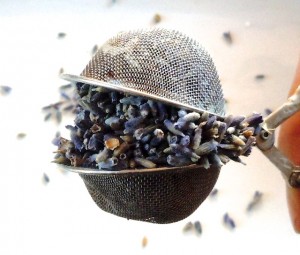 Perusing Turback’s book, I kept returning to one recipe…a lavender-infused hot chocolate. Approaching Valentine’s Day, the notion of flowers and chocolate together made perfect sense, and the potential sensory possibilities of this blend intrigued me. I have used culinary lavender in baking projects and have had it in tea, so I had some on hand to be blended with milk and bittersweet chocolate. One interesting touch to this recipe was a garnish of chopped, salted pistachios (and I can always use an excuse to eat more pistachios…they are delicious…how could I forget?). Yet more intriguing! Salt and sweet together…one of my favorite combinations.
Perusing Turback’s book, I kept returning to one recipe…a lavender-infused hot chocolate. Approaching Valentine’s Day, the notion of flowers and chocolate together made perfect sense, and the potential sensory possibilities of this blend intrigued me. I have used culinary lavender in baking projects and have had it in tea, so I had some on hand to be blended with milk and bittersweet chocolate. One interesting touch to this recipe was a garnish of chopped, salted pistachios (and I can always use an excuse to eat more pistachios…they are delicious…how could I forget?). Yet more intriguing! Salt and sweet together…one of my favorite combinations.
The dried lavender flowers are first steeped in the hot milk — a tea infuser works well for this step. Then, chopped bittersweet chocolate (a lot of it — 12 ounces) is blended in.
Chocolate and lavender are perfect partners (and I thought bacon and chocolate were a match; see blog of 2/12). The high floral note of the lavender lifts the heaviness of the chocolate. And the warmth of the drink brings all of lavender’s aromatic properties through the nose, mouth and throat. The salty crunch of the pistachios gives this hot chocolate a heartier, after-dinner, dessert quality. A lavender hot chocolate — despite the caffeine of chocolate — could be the perfect nightcap, given lavender’s relaxing properties. A spell, or perhaps, a lullaby.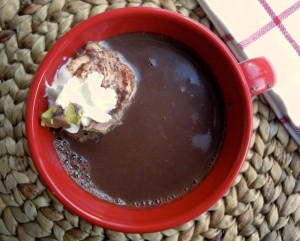
Lavender-Pistachio Hot Chocolate
Kingsbury Chocolates, Alexandria, VA
From “Hot Chocolate” by Michael Turback (2005)
Makes 4 servings
2 1/2 cups whole milk
4 teaspoons lavender
12 ounces shaved bitterweet chocolate
Whipped cream
4 tablespoons chopped roasted and salted pistachios
In a medium saucepan, bring the milk to a simmer over medium-low heat. Turn off the heat, over the pan, add the lavender and steep in the hot milk for 3 to 5 minutes. (The longer you leave the lavender in the milk, the stronger its flavor will be.) Remove the tea infuser of lavender, if using or strain the milk through a fine-mesh sieve. Add the chocolate to the warm milk and whisk vigorously until the chocolate is melted and the mixture froths. Pour equal amounts into 4 mugs, garnish each with a dollop of whipped cream, and sprinkle with shopped pistachios.
